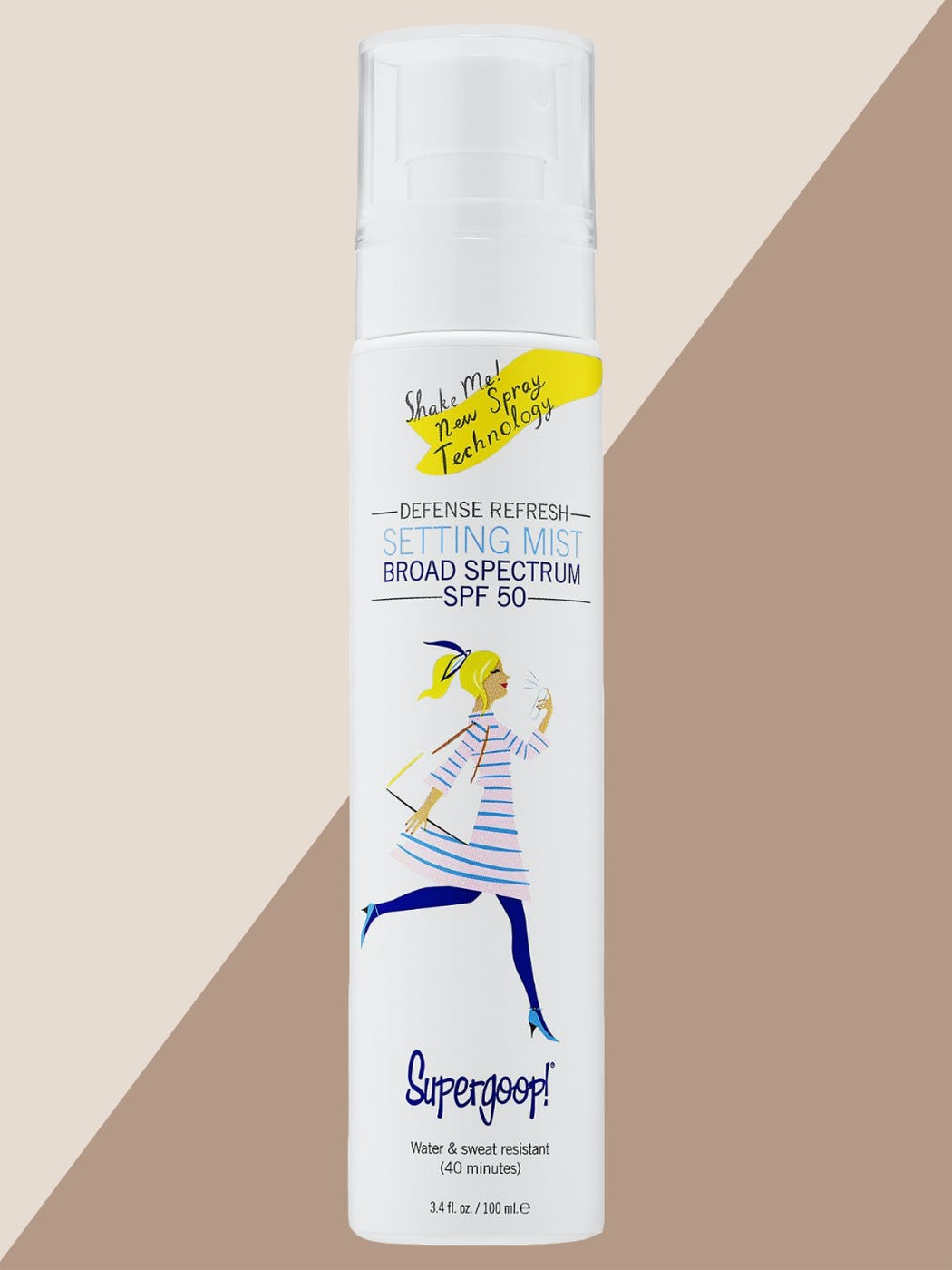The 3 Big Reasons Why Forehead Wrinkles Appear — And How To Treat Them
[email protected] | July 25, 23

Maybe you first saw yours when makeup settled in them, making them impossible to ignore. Maybe someone helpfully (ahem) pointed them out to you. No matter how they popped up on your radar, forehead wrinkles are a frustrating inevitability. While there are a few things you can do to help prevent premature development of forehead wrinkles — such as wearing SPF every single day, and not smoking — these wrinkles can get so deep that they become impossible to ignore. Today, with expert insight, we’re breaking down the common reasons why forehead wrinkles develop in the first place, then filling you in on your options to help temporarily smooth them out.
Sun Exposure And Free Radicals
Few things are as enjoyable as a day spent relaxing in the sunshine, but sun damage is the biggest cause of premature wrinkling and can exacerbate existing wrinkles even further. “Sun exposure causes free radical damage in the skin, which damages the elastin and collagen fibers, which are what give the skin its strength and elasticity,” says Marnie Nussbaum, MD, a board-certified dermatologist based in New York City. “Once these fibers are damaged, the skin starts to wrinkle, especially as we age.”
Wearing broad spectrum sunscreen with a minimum of SPF 30 every single day is very important, as is sticking to shade and wearing hats whenever possible. For your face alone, you should be slathering on a plump, raspberry-sized amount of sunscreen for adequate protection. It’s also necessary to reapply every two hours when outside or every four hours when indoors. For easy re-application over makeup, try a mist like Supergoop!® Defense Refresh Setting Mist SPF 50 ($28).

Aging And Genetics
“Our production of collagen and elastin fibers [start to] dramatically decline by age 30 — essentially decreasing by one percent each year — and, therefore, accelerates any fine lines and wrinkles,” says Dr. Nussbaum. Wrinkling speeds up when you factor in certain lifestyle choices, such as excessive sun exposure (as previously mentioned), a lackluster skincare regimen, and smoking. She adds, “Individuals who have very expressive faces are also more at risk for deeper lines due to the constant motion of the dynamic muscles in this area.” (While it is a challenge to control your facial expressions, some people successfully do so to stave off wrinkles.)
On that note, you might have noticed that some people have more — or deeper-set — forehead wrinkles compared to others. This is often a matter of genetics, though lifestyle does factor in. “Forehead musculature can come in varying sizes and shapes,” Dr. Nussbaum explains. For example, the frontalis muscle — which is the main muscle in the forehead that allows for vertical motion, or up and down expression — may be one piece, two pieces, rectangular shaped, or v-shaped.”
So, when different people make the same facial expression, different wrinkles may be formed depending on the muscle, which varies due to genetics. “Strong muscles tend to produce deeper lines,” she adds. Genetics also come into play regarding how predisposed we are to losing collagen, bone density, and muscles.

Dehydrated And Neglected Skin
Though sunscreen is the most important product you can apply to your skin to stave off forehead wrinkles, maintaining a robust skincare regimen is also key. One of the best moves you can make is routinely moisturizing, which helps to plump the look of fine lines and make them appear diminished.
Hydrating formulas that contain hyaluronic acid are particularly beneficial: the best formulations draw in and hold 1,000 times their weight in water to help smooth out the appearance of forehead wrinkles. You should also seek out moisturizers that contain ceramides, which help plump and seal in moisture.
Mildly exfoliating your skin two to three times a week with alpha hydroxy acids (AHAs), such as glycolic and lactic acid, is also beneficial. This helps your skin shed the most superficial layer of skin (including dead cells) to reveal fresh skin underneath. “This results in a brighter and firmer complexion,” Dr. Nussbaum explains. “They also have been proven to stimulate the production of collagen and elastin, which support the cellular matrix and create a firmer visage.” We’re particularly fond of the Dr. Dennis Gross® Skincare Alpha Beta® Universal Daily Peel ($150), which contains a cocktail of AHAs, including glycolic, lactic, citric, and malic acids to gently resurface skin.
Daily use of antioxidants, such as vitamin C and E, is also important in the prevention of free radical damage. They’ve also been proven to increase the effectiveness of SPF when paired with it, so layer accordingly, or try a formula that’s loaded with both vitamin C and E and sunscreen, like Murad® City Skin® Age Defense Broad Spectrum SPF 50 PA++++ ($68).
Last, but not least, you can opt to incorporate a topical retinoid into your regimen. This powerhouse ingredient can help prevent premature forehead wrinkles and reduce their appearance. Consider this treatment more of a “slow burn” and supplemental approach to treating forehead wrinkles. “Retinoids increase skin cell turnover, thereby boosting cellular renewal and sloughing the dead skin cells away,” Dr. Nussbaum says. “Retinoids have also been proven to increase collagen production and therefore increase elasticity.” She adds that you need to stick to using it religiously for three months in order to see visible results. You can find retinol at your local drugstore, or you ask your dermatologist about a prescription for retinoic acid.
[Retinol shouldn’t be used by those who are pregnant, considering getting pregnant, or nursing. Please consult with your doctor before use.]

Treatments To Help Temporarily Smooth The Appearance Of Forehead Wrinkles
Unfortunately, once moderate to severe forehead wrinkles set in, they won’t just go away on their own. The good news is there are options to improve their appearance!
“Injectable neurotoxins are particularly effective at combating forehead wrinkles by temporarily [reducing the movement] of the underlying facial muscles in the desired locations,” says Dr. Nussbaum. “The injected muscle is no longer able to [fully] contract, and therefore causes a [smoother appearance] of the overlying wrinkle.” You’ll may start to see softening of the appearance of forehead wrinkles one week after treatment with injectable wrinkle reducer (with the full results kicking in at one month), and retreatment is recommended no more frequently than every three months. Consult with our team of trained aesthetic specialists to find a licensed provider in your area.
[Editor’s note: Injectable wrinkle reducers are used to temporarily smooth the look of moderate to severe wrinkles in certain areas of the face such as the forehead, frown lines, and crow’s feet. They should not be used more frequently than every three months. Like any medical treatment, they have potential risks and side effects. Be sure to talk to a licensed provider to see if they’re right for you.]
Other in-office options to treat those not-so-deep forehead wrinkles are laser treatments, which help stimulate new collagen and elastic production. “I personally love both the Fraxel® 1550 laser for fine lines and wrinkles, as well as the Clear + Brilliant® laser,” says Dr. Nussbaum. “Both create microscopic laser columns that penetrate the skin at various levels to remodel the collagen and stimulate new collagen and elastin.” Bonus: they also decrease pigmentation and can help improve sun damage.” Fraxel and Clear + Brilliant often require a series of treatments (generally two to four) with several weeks between each for best results.
Another skin resurfacing option for fine wrinkles is a professional chemical peel. The at-home treatments that you can buy are formulated to be very mild and safe for amateur use, so they’re not as powerful as something that would be administered by a licensed professional. (Translation: the results aren’t as powerful, either.) You can graduate to something stronger, which will generate more noticeable smoothing of forehead wrinkles, via an in-office trichloroacetic acid (TCA) chemical peel. This treatment sloughs off skin all the way to the mid-dermis, which helps stimulate collagen production in addition to smoothing the forehead surface. However, you’ll need to plan accordingly — downtime lasts about two weeks, with noticeable redness, peeling, and sensitivity.
Product prices may vary from the time this article was written.
Allergan® may receive commissions for purchases made through links in this article.






